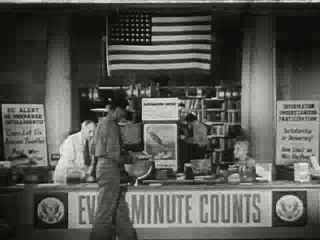During World War II, Wilson Library (then the University Library) was home to the War Information Center, a hub of information and resources related to the war effort.

Briefly called the “Information Center on Civilian Morale,” the Center opened on December 8, 1941: the day after the attack on Pearl Harbor. Plans for the Center had been in the works for at least a month, but its organizers recognized the immediate need for information as the United States entered the war. The Center was supervised by librarian Katherine Kirtley Weed until the spring of 1942, when librarian Agatha Boyd Adams took on the role.
The War Information Center provided access to books, pamphlets, maps, charts, posters, and news on a wide variety of topics related to the war. Its original collection was drawn from the library’s existing collection, consisting largely of reference materials on countries involved in the war. The collection grew quickly as librarians purchased additional materials and added publications distributed by the United Nations and US government agencies. To make sure up-to-date information was available to students, librarians didn’t catalog the materials, instead making them immediately available on the Center’s open shelves. At its height, the collection consisted of roughly 20,000 pamphlets and 2,000 books (regularly weeded for outdated materials). Center volunteers – 16 women in the first half of 1942 – clipped relevant articles from newspapers, maintained a newspaper clipping file, and staffed the desk.
The Center’s impact was not confined to campus. Its services were open to all North Carolina citizens. The Center distributed reading lists across the state, and discussion groups could borrow “discussion packets” including books and pamphlets by mail. It also provided reference services to state agencies.
The Center closed shortly after the war ended and its books were cataloged and absorbed into the library’s general collections.
Sources:
Office of the University Librarian at the University of North Carolina at Chapel Hill Records (#40047)
Cranford, H.C. “Local Morale Information Center Among First in Nation.” Daily Tar Heel, January 25, 1942.
